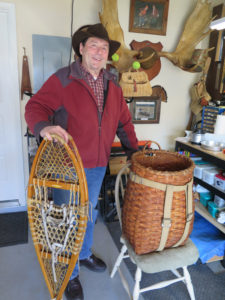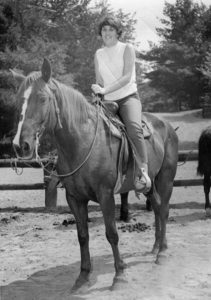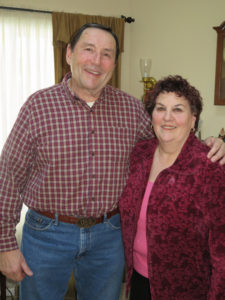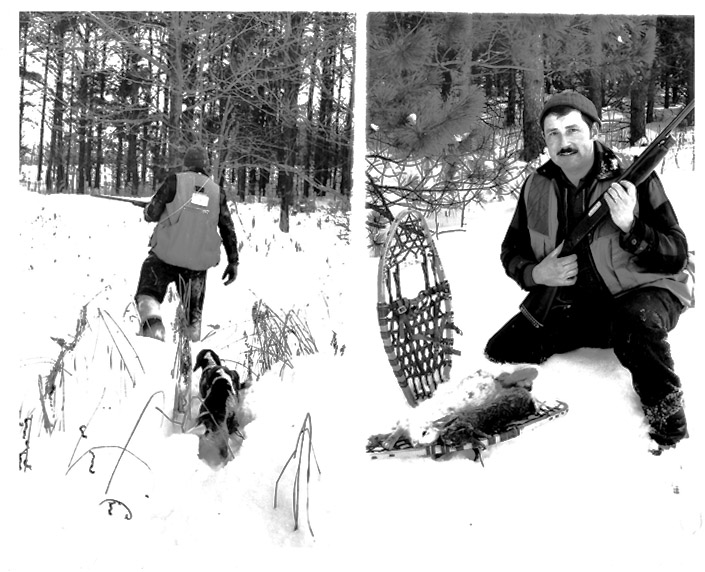By Mark Frost, Chronicle Editor
Sometimes stories result from chance meetings. I happened to meet Lionel Lemery and his wife Mary Ellen at the Warrensburgh Historical Museum last November at the presentation about when Marilyn Monroe came to town in 1949.
Lionel, 72, and I got to talking. One of the things he told me is that as a young man he did on-the-ground survey work laying out the path of the Adirondack Northway between North Hudson and Underwood, now Exits 29 to 30. He was employed by the Rist-Frost Engineering firm.
“It was 1964, so I was 21,” said Lionel. “We worked hard. We had to carry all of our stuff several miles in, work hard all day and then carry it all out. I was young and full of piss and vinegar.” Sometimes they navigated swamps, he said.
Lionel said his pack basket was “two-thirds full of iron pins, two rolls of lath gathered over my shoulder…The pins were for making the turning points. We didn’t have all the electronic distance measures and GPS” employed today.

He carried a map, a compass, levels and a temperature gauge. He said they had to “pull a certain tension on the steel tape” by which they marked the route.
The more Lionel and I got to talking, the more I found his life a quintessential story of a northern New Yorker of a given generation, specifically a Glens Falls native involved for life in the local heritage of forest and wood.
Not by chance Lionel’s truck bears the bumper stickers: “Trees Are The Answer” and “Wood Is Good.”
His upbringing on Third Street
Lionel grew up on Third Street of modest means. He said he earned money as a boy delivering a newspaper route (he pronounces it “rout”) and “worked at Dobert’s Dairy in high school scooping ice cream. I grew up with Gary Dobert.” The dairy was around the corner from Lionel’s house.
Lionel has two other lifelong friends from Third Street — Lee Comar and Dick McCarthy. Lionel and Lee graduated from Glens Falls High School, Dick from St. Mary’s Academy.
After high school, Lionel said he worked at the Finch, Pruyn paper mill “in the wood room” feeding “four-foot sticks of hardwood pulp” into the chipper.
“Back then,” he said, “you had minimal ear protection, and the chipper would scream every time you put a log down. You’d hear it screaming all night at you.”
It was grueling, precise work, said Lionel. He said the “sticks” would weight “several hundred pounds” and “if you didn’t time it just right, it would jam it,” causing the whole chipping operation to shut down.
He said the sticks “couldn’t have bark, couldn’t be too wide,” couldn’t have too much bend.
He calls it a job where “you count the days,” and it reinforced in his mind that it was worth pursuing further education.
Went to Ranger School in 1962
Lionel said he started the Finch job in autumn 1962 and did it until March 1963 when “I went to the New York State Ranger School. Now it’s call SUNY ESF Ranger School.”
Back then, said Lionel, “it was a very intensive 44-week course…split between forest technology and land surveying. Fifty percent of the class went into surveying.”
Lionel called the school “the model of its day.” Founded in 1912, he said it was the “oldest forest tech school in the country.”
“There was no tuition charge,” he said. “All we had to pay was room and board. It enabled me to get a saleable skill.”
He says that President Obama cites America’s need to develop new approaches to education, and Lionel sees that Ranger School approach as a worthy model.
He noted that students also had to provide “two pieces of required equipment” — a pack basket and snowshoes. Lionel took me out to his garage and showed me his still still intact pack basket, which he bought a half-century ago from LL Bean.
Lionel said that at Ranger School he learned how to keep a survey notebook, and “they were very insistent that all of our notes were meticulously lettered.”
That led to Lionel’s hiring as a draftsman at Rist-Frost. Meanwhile, his formal education continued. “I went to ACC [now SUNY Adirondack] for a year. That’s when they were in Hudson Falls, Fort Edward.”
And then onto the University of Maine Orono, which Lionel said accepted his credits from Ranger School and ACC. “I majored in Forest Management.”
Lionel notes in passing, “I was the first of my family to go to college.”
After “5 1/2 years of college,” he says he owed just $700 when he was done. Of course, he was earning his way, summers and at other times.
“Rist Frost let me work evenings in some drafting work and holidays sometimes.”
And Lionel went back to Finch, Pruyn. He said a sign on the window said “No applications being accepted,” but when the Superintendent of the Pulp Mill saw him, he said, “Lemery, you come to work.” Lionel said the exception was made “because I came to work every day and they couldn’t find anybody who was dependable.”
After graduating from the University of Maine Orono, Lionel started “a 34-year career with the U.S. Forest Service,” with posts in five different states.
Met his bride at Hidden Valley
Mary Ellen has been with Lionel for this life journey. Their meeting, in August 1965, is quintessentially Adirondack too.

“We met 50 years ago. We met up in Lake George,” said Mary Ellen. “We’re gonna be married 50 years in September.”
Mary Ellen was from Deer Park, Long Island. Fatefully she and her girl friend Gerrie Bartalini [married name Yachnik] spent $100 to vacation for a week at Hidden Valley, which dubbed itself “America’s Finest Dude Ranch.”
Today it’s home to the Double H Hole in the Woods Ranch for critically ill children, in Lake Luzerne.
Lionel was at Hidden Valley for “a stag party” for his friend Lee Comar “the day before he got married.”
Mary Ellen says her friend Gerrie was a beauty who drew lots of attention. “All the guys were asking her to dance.” Mary Ellen says she decided “I’m gonna get my hundred dollars worth.”
Lionel approached her. He says, “We danced and the more I got to know her the more interested I became.”
Mary Ellen says Gerrie — still a close friend — “actually told me the second or third night I went on a date, I said that’s the guy I’m going to marry.”
Self-effacing Mary Ellen quips, “I think he married me for my Mercury Comet — I worked for the car dealer — and for my typewriter.”
The Lemerys describe their wedding — on Labor Day 1966 — as “spartan.” Mary Ellen’s parents gave them a choice — they’d either pay for the wedding or pay off their car loan. Lionel and Mary Ellen opted to pay off the car.

34 years in the U.S. Forest Service
Lionel’s Forest Service career took them to five states, concluding at the Allegheny National Forest in western Pennsylvania. “That’s the job I retired from.”
The Forest Service, Lionel explains, is part of the U.S. Department of Agriculture, in contrast to the Park Service, which is in the Department of Interior.
Lionel says the Forest Service “multiple use” mission involved use of natural resources — assuring a steady supply of wood products for American industry — as well as protecting the headwaters of navigable streams.
He notes that the Allegheny National Forest even encompasses 10,000 oil and gas wells plus coal mines — spanning “all the way from that to extreme wilderness.”
Lionel said the mission is “always to improve the forest and make right decisions,” but the work has become increasingly political and the Forest Service embattled.
“The Forest Service was really being attacked nationally for their Timber Management program” by “people who didn’t feel the national Forest Service should be harvesting timber,” he said.
He says, “The Forest Service has changed somewhat. There’s a lot less timber production than there used to be.” He said “part of it is the market has declined,” but after the mandate to protect Spotted Owl habitat, “timber production in the Northwest just collapsed.”
Lionel cites “very intense pressure by some groups of people to change the mission of the Forest Service without going through Congress” to pass required legislation. He talks of some projects being “monkey wrenched” at the same time that the Forest Service is also trying to protect Wild Rivers.
“You were always trying to weave your way in the middle,” says Lionel, who retired in 2002. He says he knew “it was time…when I saw the best and the brightest of our industry [wrapped up in] cartons of paper that were going to the U.S. Attorney to address all this very frivolous stuff.”
Budgets got tight. “The Forest Service has become one large fire department,” says Lionel. Fire-fighting consumes “more than 50% of their budget, which when I worked it was 10 to 12%.”
When the Siberian foresters visited
Lionel recalls several career highlights. He hosted three Russian foresters who came to study U.S. methods. “They managed millions of acres of Siberian forest, a much larger area than we did, with much fewer resources,” says Lionel. He said there was still “a lot of use of horses” and the woods were very much “used for subsistence — gathering mushrooms, gathering nuts, gathering berries.”
When Lionel worked in Ohio, the restaurant founder Bob Evans was a big supporter of the national forest. In response to a Reagan-era plan to sell off parts of the forest there, Evans organized “an aerial and bus tour of all the national forests in the state. The bottom-line was he convinced people that it was a very valuable asset. Not only did we never dispose of any land, the forest expanded significantly. That was gratifying.”
Speaking at a Wild Scenic River conference in Minnesota, Lionel says, “Walter Mondale’s name was just above mine in the program. Gaylord Nelson was there, too.” The men were U.S. Senators from Minnesota and Wisconsin, respectively, and Mondale was Jimmy Carter’s Vice-President.
Active retirement, a move to Qby.
In retirement, the Lemerys stayed in Pennsylvania until last year. Lionel became a Master Gardener and was active in the Pennsylvania State Cooperative Extension He is also active in the American Chestnut Foundation, which he says is trying to bring back the classic species which still has “scattered surviving remnants of the original population.”
But he may have made his biggest mark turning 34 acres of unmanaged land that a couple had inherited into a model forest conducive to sustainable logging, recreation and wildlife habitat. He created a three-acre pond and planted more than 2,000 trees “by hand,” says Mary Ellen. And “he went out and hand-watered them”
“It was a really rewarding project,” says Lionel.
Last year the Lemerys finally came home. They moved to Queensbury.
“He’s in hog heaven,” says Mary Ellen.
Weekly now, Lionel says he gets together with the pals of his youth, Lee Comar and Dick McCarthy.
Lionel spent a lifetime in outdoor recreational pursuits — canoeing, hunting with his beagles, hiking — but a health ailment limits his walking now.
The Lemerys say they enjoy Crandall Public Library in Glens Falls and Hudson River Music Hall in Hudson Falls.
They also have three children — Mark 47, a retired Lt. Colonel in the Air Force; Matthew, 45, an auditor for a federal agency in Washington, D.C.; and Chris, 36, a government document librarian at University of Pittsburgh.
The Lemerys host and travel to see seven grandchildren in far-flung destinations — Iceland, northern Virginia and Utah.
Incidentally, Lionel’s maternal grandfather was Arnold Stone of North Creek, a left-hander who pitched for the Pittsburgh Pirates in 1923-24.

Copyright © 2016 Lone Oak Publishing Co., Inc. All Rights Reserved.
 Glens Falls Chronicle Serving the Glens Falls/Lake George region; Warren, Washington and northern Saratoga counties since 1980
Glens Falls Chronicle Serving the Glens Falls/Lake George region; Warren, Washington and northern Saratoga counties since 1980

